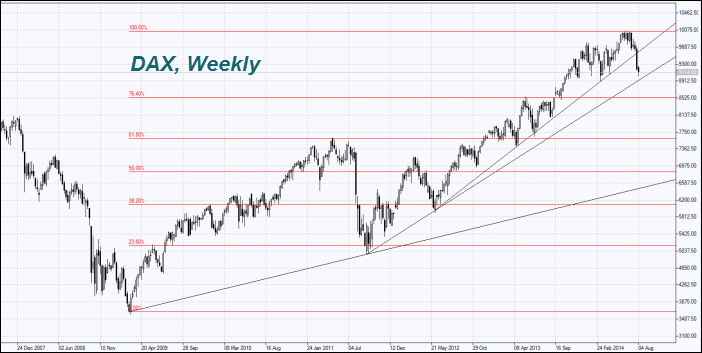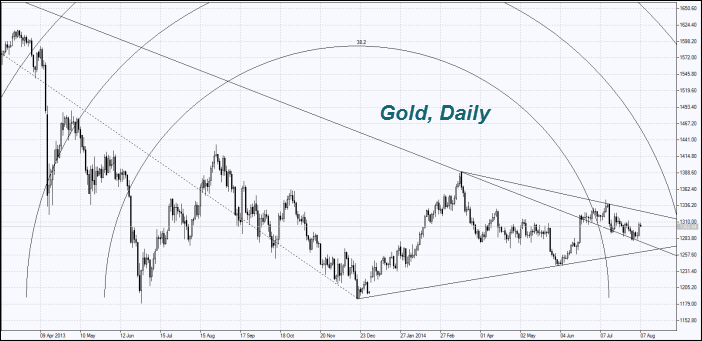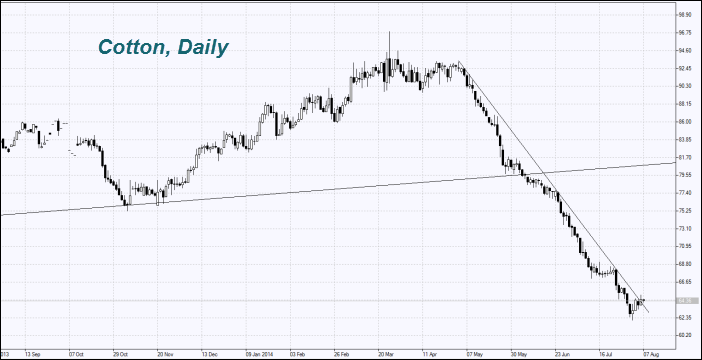By IFCMarkets
European stock indices slipped on Wednesday, meanwhile the American ones barely changed, according to trade results. The US foreign trade deficit in June fell 7% to a 5-month low and amounted to -$41.5 billion.
This is far better than the preliminary forecasts. Reduced oil imports contributed to such a result, the imports fell to its 3,5-year low to $27.5 billion. Now the US GDP growth forecast for the second quarter may be revised upward. It may amount to +4.2%, according to JPMorgan Chase. However, the market reaction on the American positive macroeconomic data appeared to be weak amid the Ukraine political tension aggravation. Russia banned the supply of a range of goods from Western countries in response to the previously imposed economic sanctions. The volume of trading on the US stock exchanges was 6% lower than the 5-day average, and amounted to 6.4 billion of stocks. The data on American labor market for this week is to be released today at 12-30 CET. The preliminary forecast proves to be moderately positive. However, futures on American stock indices are still “in the red” now.

European stocks continue the falling today. As we have already mentioned, the Ukraine crisis can be considered as a more negative factor for the EU than for the U.S. The data on German industrial output in June came out in the morning. It is logical that it appeared to be negative after the weak data on factory orders was released yesterday. The ECB meeting will take place today at 11-45 CET. The current low level of the discount rates will be maintained, according to forecasts. The ECB President Mario Draghi is to give a speech at 12-30 CET. Market participants expect him to announce the existence of the negative European economy trends and the need for its further monetary incentive. For this reason, the Euro rate is also decreasing today. This movement is confirmed by the debt market rate. The yield of the American 10-year government bond fell to 2.46%, and the German slipped to 1.08%. In the long term, a difference in yields is justified by significantly higher inflation in the United States compared to the EU. Let us note that the P/E ratio (stock price/ annual earnings per share) of Stoxx Europe 600 amounts to 14.9. S&P 500 is 16.1, and MSCI Asia Pacific makes 13.4. It is generally considered that the lower the P/E ratio is, the more there is a potential for the quotes growth. Moreover, the average level of this index amounts to 12. Higher values of P/E ratio emerge when investors expect a substantial increase in corporate profits.
Nikkei dropped to the lowest boundary of the neutral range, and has “bounced” upstairs today. The statements made by representatives of the largest in the world, the Japanese Government Pension Investment Fund, considering the revision of the investment portfolio contribute to the index growth. The fund’s assets amount to 126.6 trillion yen ($1.24 trillion.). Meanwhile, it plans to increase the stock proportion of Japanese companies from the current 12% to 20%, but in the future it may become even more increased. Japanese trade balance for June is to be released tonight at the 23-50 CET, as well as a number of banking system indicators. Moreover, the Bank of Japan will make a statement on the objectives and the individual parameters of its monetary policy. We assume that the economic data forecasts for Nikkei are positive. The Bank of Japan is likely to favor the yen depreciation.

As anticipated, gold has boosted in price significantly amid the Ukraine political crisis around. This happened as there was a dollar downward correction yesterday, from its nine-month high against the euro. Gold prices boost has not yet been accompanied by an increase in trading volumes. There was a decline in SPDR Gold Trust reserves on Wednesday by 2.4 tons to 797.65 tons. The volume of trading for gold futures was 19% less than the three-month average. Silver prices had a weak increase, because they are being pressed by the weak demand for bullion coins. We wrote about it in the previous market overview.

Cotton prices ticked up due to the possible crop reduction by 50% in Australia in the next season, due to a severe drought. Cotton production may be the lowest since 2009/2010. The cotton crop for 2014/2015 from 2 to 2.5 million bales (227 kg or 500 pounds in each bale), according to Cotton Australia Group forecasts. Australian Cotton Shippers Association expects it to be 2.25 million bales. In the current season of 2013/2014 the crop is planned to amount to 4 million bales. Note that the USDA predicts more a moderate decline in the cotton crop in Australia, only 34% in 2014/2015. Australia is the third world largest producer of cotton. Australian Bureau of Agricultural and Resource Economics and Sciences expects exports to be reduced by 11% in the next season, and still has not revised the old crop estimate of $3.6 million bales. We assume that the cotton prices growth may continue, in case the official agencies in Australia and the United States also start to reduce their forecasts.
Market Analysis provided by IFCMarkets